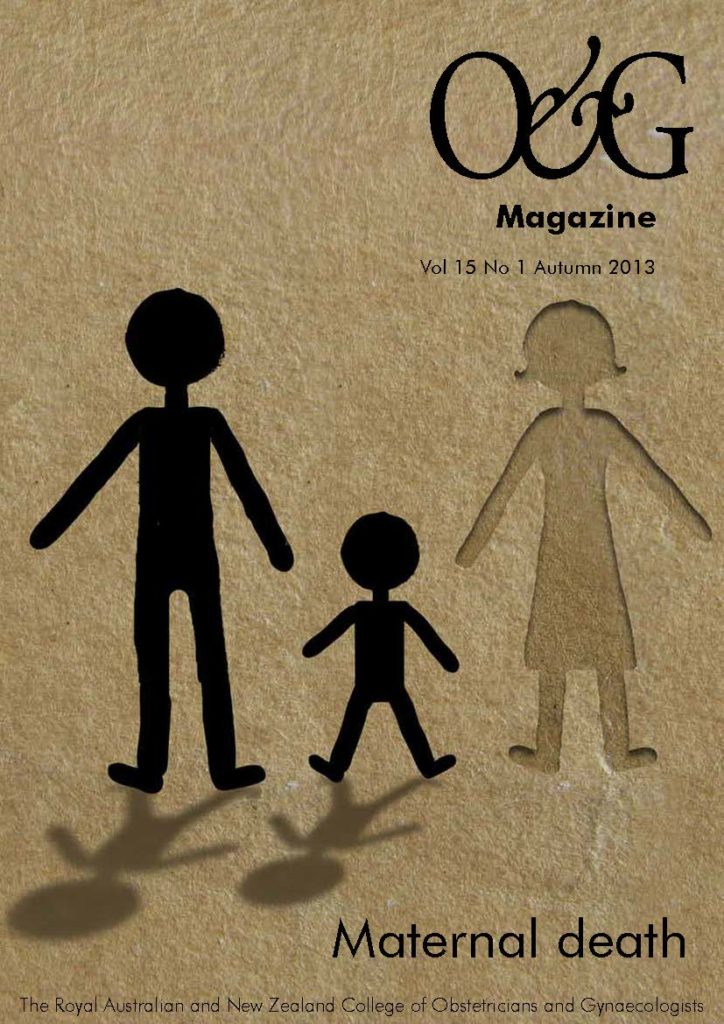The challenges and benefits of collecting national data.
Maternal deaths are rare events in Australia, with an estimated 8.4 deaths per 100 000 women who give birth.1 This statistic compares favourably with New Zealand (2006–10 maternal mortality rate 17.8 [95 per cent CI 13.5–23] maternal deaths per 100, 000 live births2) and is significantly lower than Australia’s regional neighbours in Timor Este and the Oceania region (maternal mortality rate 300 maternal deaths per 100 000 live births and 200 maternal deaths per 100 000 live births, respectively2) and, internationally, with Sub- Saharan Africa, where there are almost 500 maternal deaths per 100 000 live births.2
Australia instigated the practice of reviewing and reporting maternal deaths for the triennium 1964–6; maternal deaths have decreased by nearly two-thirds since this time.1 The next maternal death report, covering the years 2006–10, will be published in 2013. These national reports are informed by the UK’s ‘Saving Mothers’ Lives’ series, which internationally are considered the gold standard in obstetric mortality review. ‘Observational methodology is used to generate hypotheses, show trend lines and make recommendations that may lead to improvements in maternal health.’3 Key to this methodology is the adoption of a focus on learning, not simply the counting and reporting of numbers. ‘Maternal Deaths in Australia 2006–10’ report is currently being prepared as an output of the Maternal Mortality project. The Maternal Mortality project is part of the larger National Maternity Data Development Project funded by the Department of Health and Ageing that the National Perinatal Epidemiology and Statistics Unit (NPESU) is undertaking in collaboration with the Australian Institute of Health and Welfare.
Identifying maternal deaths
There is no national standard for notification of maternal deaths in Australia, with methods varying by jurisdictions. Maternal deaths are usually notified to the Department of Health, or equivalent, in each jurisdiction. The most common form of identification is direct notification by health professionals and hospitals involved in a death. In other cases, deaths may be reported by the coroner or the Registrar of Births, Deaths and Marriages. The latter follows identification by use of the ‘pregnancy tick box’ at death registration (which indicates if a woman has been pregnant within the year preceding her death). Some jurisdictions search for maternal deaths using hospital administrative data collections. Nationally, there is no mandatory reporting requirement, meaning health professionals are not obliged to report a maternal death or to provide information for use at confidential enquiry. An overall lack of clarity and consistency in reporting requirements means maternal deaths have been historically under-reported in Australia, with evidence showing up to 20 per cent of maternal deaths are never reported or investigated.4
Jurisdictional-level reporting
Following notification of a maternal death to the relevant authority, all deaths undergo some form of a confidential enquiry. These enquiries are undertaken by specifically convened jurisdictional Maternal Mortality Committees (MMCs). Information is collected through audit of the medical notes, inclusion of the coroner or autopsy data and through interview with the relevant staff associated with the case. Each jurisdiction has varying policy, legislation and methods for collecting data on maternal deaths and in turn the quality and amount of data collected varies by jurisdiction, as does the consistency and timeliness of review. The confidential enquiry can be subject to significant delays, with some reviews occurring up to two years after the death has occurred. At the national level, these inconsistencies across jurisdictions mean the details of any particular woman and any conclusions or classifications made by jurisdictional committees can be difficult to compare.
National-level reporting
In contrast to the UK and New Zealand, national maternal death review is not the primary method of review in Australia and is undertaken on an ad hoc basis, subject to funding. A national reporting form, which collects a standard set of information on all deaths, is distributed to each jurisdiction and data commencing with the 1994–6 triennium has been provided to the NPESU on a voluntary basis. Limited resources impact on the timeliness of supply, the quality of information and the capacity to draw useful comparisons or conclusions. Legislative privacy restrictions that are intended to protect the privacy of individual women and promote open disclosure at confidential enquiry result in the limited transfer of information from the jurisdictional committees to the national committees. For the 2006–10 maternal death report, the data provided to the NPESU varied by jurisdictions, which impacts the utility of national reporting.
Recent developments in maternal death review
In 2011, the National Maternal Mortality Advisory Committee was reconvened. This committee – mainly consisting of senior clinicians, many of whom are dedicated to the improvement of maternal health, with rich experience in maternal death review – has provided an excellent opportunity for discussion and exploration of options for the improvement of the current maternal death reporting system. Progress to date includes the development and piloting of a nationally standardised National Maternal Death Reporting Form, intended for implementation in 2013; the development of a nationally standardised system of classification for deaths related to psychosocial morbidity that is currently under review by the MMCs; and the undertaking of a national data linkage study on maternal deaths that, for the first time, will provide an accurate assessment of the number of maternal and late maternal deaths in Australia. It is intended that these developments will improve the consistency of maternal death ascertainment and data collection. Novel collaborations with comparable patient death enquiry bodies such as the Australia and New Zealand Audit of Surgical Mortality and the New South Wales Clinical Excellence Commission, aim to facilitate the development of effective national-level reporting in a state-based system.
The proposed introduction of a rapid maternal death surveillance system represents a significant change to the process of national maternal death review. The Australasian Maternity Outcomes Surveillance System proposes to collect monthly notifications on in-hospital maternal deaths Australia-wide. This system will allow rapid response to emerging trends in maternal mortality, such as the 2009 H1N1 epidemic. It may also serve to raise the culture of awareness of maternal death reporting at the hospital level with the long-term effect of improving jurisdictional maternal death notification.
Conclusion
Australia has one of the lowest maternal mortality rates in the world. Confidential enquiry is an internationally adopted method of review for maternal deaths. Work is underway to develop a systematic national approach for the reporting of maternal deaths in Australia. Mandatory notification requirements, improved consistency in the information collected and the responsible sharing of information between coroners, jurisdictional committees and national committees has the capacity to significantly enhance the current system. Recent developments in the process of national review indicate a climate of progress and change. Continued support and leadership from RANZCOG and the Australian College of Midwives is essential in the development of sustainable national reporting system of maternal deaths and in the adoption of a focus on learning and translation of findings into practice.
References
- Sullivan, E., B. Hall, and J. King, Maternal Deaths in Australia 2003- 2005, in Maternal Deaths Series no.3. Cat. no. PER 422007, AIHW National Perinatal Statistics Unit: Sydney.
- WHO, UNICEF, and The World Bank Estimate, Trends in maternal mortality: 1990 to 2010, 2012, The World Health Organisation: Geneva.
- Centre for Maternal and Child health Enquiries (CMACE), Saving Mothers’ Lives: Reviewing maternal deaths to make motherhood safer: 2006–2008. BJOG, 2011. 118(Suppl. 1): p. 1-203.
- Sullivan, E., et al., Maternal deaths in New South Wales, Australia: A data linkage project. ANZJOG 2008. 48(3): p. 255-60.







Leave a Reply